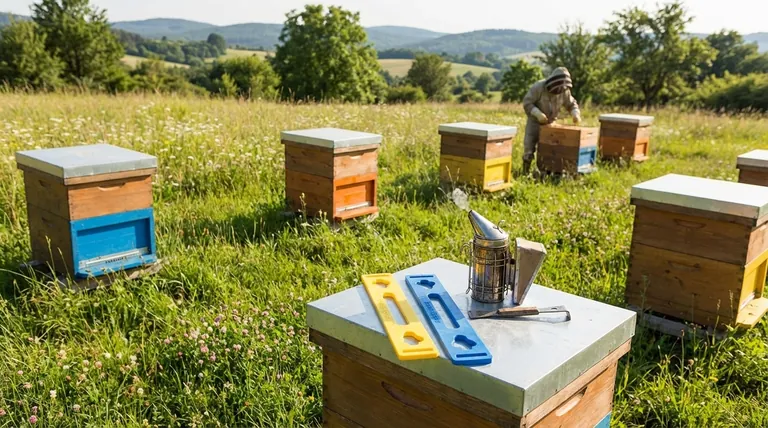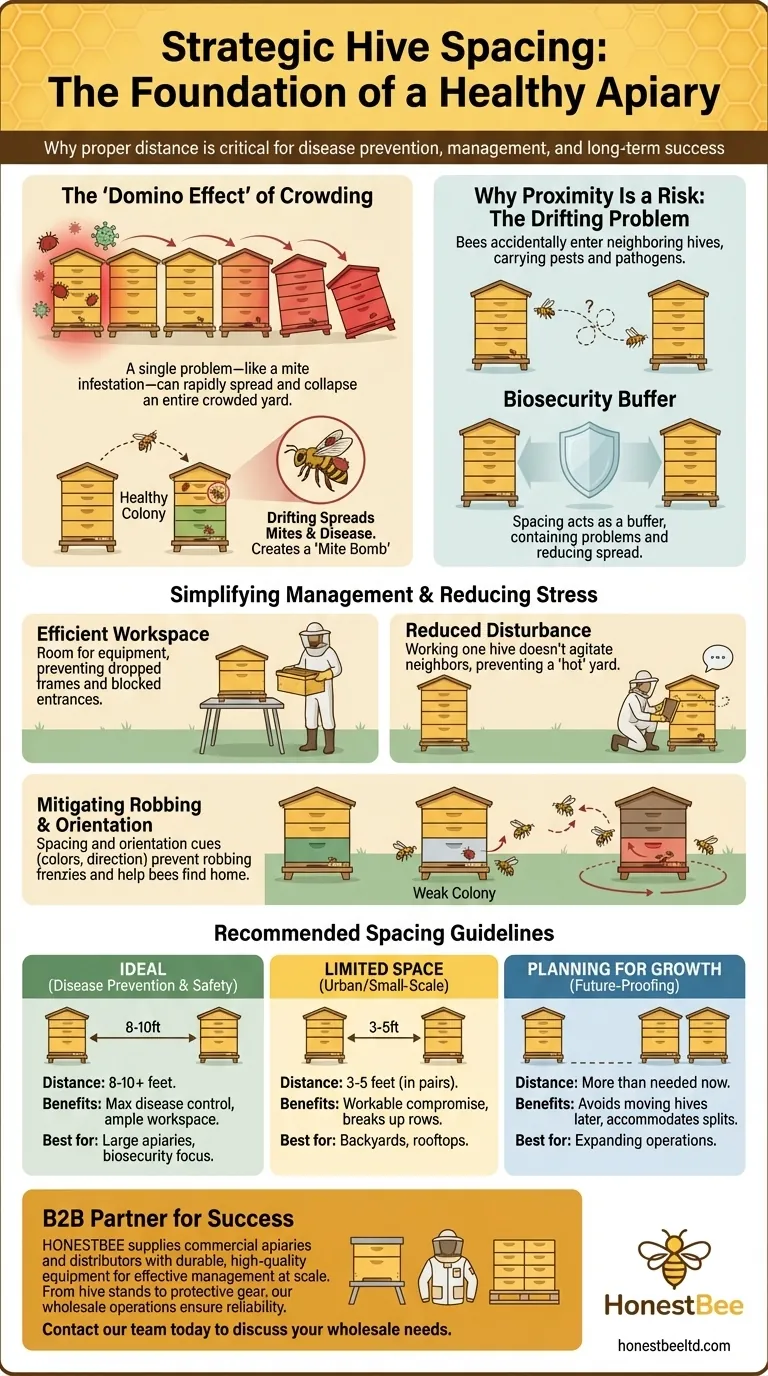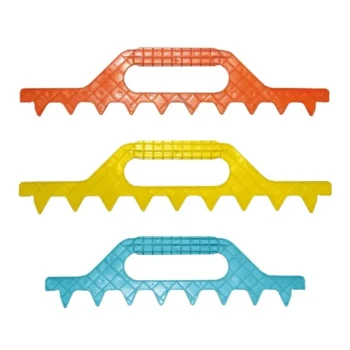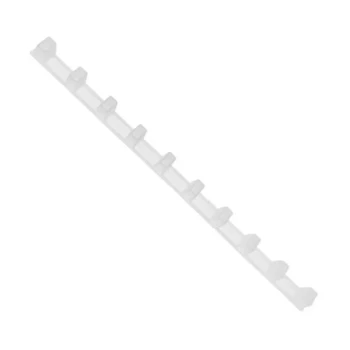Proper spacing in a bee yard is one of the most critical factors for hive health and sustainable beekeeping. While it may seem like a simple matter of logistics, the distance between your hives directly impacts disease transmission, pest management, hive behavior, and your own ability to work effectively and safely. It is a foundational decision that prevents future problems.
The core principle to understand is that apiary layout is not about giving bees more room to fly; it is a strategic defense against the "domino effect," where a single problem in one colony—like a Varroa mite infestation or disease—can rapidly spread and collapse an entire bee yard.

Why Proximity Is a Risk Factor
A crowded bee yard creates an unnatural, high-density environment that amplifies common beekeeping challenges. Proper spacing is your primary tool for mitigating these risks before they begin.
The "Drifting" Problem
Bees are not perfect navigators. When hives are placed too closely together and look identical, foraging bees returning to the apiary can accidentally enter a neighboring hive. This phenomenon is known as drifting.
Younger bees are particularly prone to drifting, and this seemingly innocent mistake is a primary vector for pests and pathogens.
How Drifting Spreads Mites and Disease
A bee carrying Varroa mites, the single greatest threat to honey bee health, can drift into a healthy colony and introduce a new infestation.
The same is true for viruses like Deformed Wing Virus (DWV) or bacterial infections like foulbrood. A single, undiagnosed sick hive can quickly infect its neighbors, turning your apiary into a disease reservoir.
Creating a Health Buffer
Spacing hives several feet apart acts as a crucial biosecurity buffer. It significantly reduces the likelihood of drifting, forcing bees to orient more carefully to their specific hive. This simple act of separation helps contain problems to a single colony, giving you time to intervene.
Simplifying Hive Management and Inspection
Your ability to effectively manage your bees is directly related to the physical space you have to work. A cramped setup makes every inspection more difficult and stressful for both you and the bees.
Physical Workspace for the Beekeeper
During an inspection, you need to disassemble the hive. You need a clean, stable place to set the outer cover, inner cover, and any heavy honey supers you remove.
If hives are too close, you will be constantly juggling equipment, blocking adjacent hive entrances, and increasing the risk of dropping a frame or angering another colony.
Reducing Disturbance to Neighboring Hives
Working one hive inevitably creates vibrations and releases alarm pheromones. If another hive's entrance is just a foot or two away, its guard bees will likely become agitated and defensive.
This can create a chain reaction, making the entire yard "hot" (aggressive) and turning a simple inspection into a stressful ordeal. Proper spacing isolates the disturbance to the colony you are actively working.
Mitigating Robbing and Swarming Behavior
Hive spacing also influences natural bee behaviors like robbing and swarming, allowing you to manage them more effectively.
Preventing Robbing Frenzies
Robbing occurs when bees from a strong colony invade a weaker one to steal its honey stores. This is a violent event that can destroy the weak colony.
Hives placed very close together make it easier for would-be robbers to discover and overwhelm a weak neighbor. Spacing makes it harder for robbing to escalate into a yard-wide frenzy.
Encouraging Proper Orientation
Beyond just distance, you can help bees find their correct home by facing hive entrances in slightly different directions. Combining this with unique colors or symbols painted on the hives further reduces drifting and confusion.
Understanding the Trade-offs
While ample spacing is the ideal, beekeepers often face constraints. Understanding the risks of a denser setup is key to managing it properly.
The Lure of High Density
Beekeepers with limited yard space may be tempted to place hives in a tight, straight line. While this can look neat and save space, it maximizes the risk of drifting and disease spread.
The Domino Effect of Collapse
The most significant pitfall of a crowded yard is the speed at which things can go wrong. A Varroa mite bomb—a colony whose mite population has exploded—can decimate an entire tightly-packed apiary in a matter of weeks.
Overlooking Future Growth
A common mistake is to plan your layout for the two hives you have today. Beekeeping is an exercise in growth; successful colonies will be split into new ones. Plan your spacing for the number of hives you aspire to have, not the number you currently manage.
Recommended Spacing for Your Goals
Your ideal spacing depends on your goals and constraints. Use these principles as a guide.
- If your primary focus is disease prevention and beekeeper safety (Ideal Setup): Aim for at least 8-10 feet between hives. Face entrances in different directions and use landmarks or different colors to aid bee orientation.
- If you have limited space (Urban or Small-Scale): A minimum of 3-5 feet between hives is a workable compromise. Arrange hives in pairs with a larger gap between each pair to create "neighborhoods" and break up long, confusing rows.
- If you are planning for future growth: Lay out your apiary with more space than you currently need. Placing four hives in an area that could eventually hold eight ensures you won't have to move them later.
Thoughtful apiary design is the foundation of a healthy, resilient, and enjoyable beekeeping operation.
Summary Table:
| Spacing Goal | Recommended Distance | Key Benefits |
|---|---|---|
| Disease Prevention & Safety (Ideal) | 8-10 feet | Reduces drifting, contains disease, provides ample workspace. |
| Limited Space (Urban/Backyard) | 3-5 feet | A workable compromise; pair hives with larger gaps between pairs. |
| Planning for Future Growth | More than currently needed | Avoids moving hives later; accommodates colony splits and expansion. |
Build a healthier, more productive apiary with the right equipment. Proper hive spacing is just one part of a successful operation. HONESTBEE supplies commercial apiaries and beekeeping equipment distributors with the durable, high-quality supplies needed to manage hives effectively and at scale. From hive stands to protective gear, our wholesale-focused operations ensure you get the reliable equipment your business depends on. Contact our team today to discuss your wholesale needs and how we can support your beekeeping success.
Visual Guide

Related Products
- Ergonomic Plastic Frame Spacer Tool for Rapid Hive Management Beekeeping
- Durable Plastic Frame Spacer
- Stainless Steel 9 Frame Hive Spacer Durable Precise for Commercial Beekeeping
- Multi-Function Hive Tool with Integrated Hammer for Beekeeping
- Professional Castellated Iron Frame Spacer for Multiple Hive Types
People Also Ask
- Why use 9 frames in a 10 frame hive? Optimize Honey Harvesting with Strategic Spacing
- Why are my bees building combs between frames? Fix Cross Comb for Better Hive Management
- What is 'Bee Space' or 'Bee Passage' and why is it important in beekeeping? The Key to Modern Hive Management
- Why is it important to compress frames together in the center of the box after reassembly? Prevent Burr Comb and Hive Chaos
- What is 'bee space' and why is it important? The Key to Modern Beekeeping Success



















